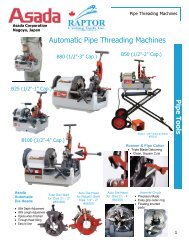March 2006 - Plumbing & HVAC
March 2006 - Plumbing & HVAC
March 2006 - Plumbing & HVAC
Create successful ePaper yourself
Turn your PDF publications into a flip-book with our unique Google optimized e-Paper software.
E-BusinessCutting the paper trailWireless technology becomes affordableBy Simon BlakeThe operating principle behind wirelesssystems available to the plumbingand <strong>HVAC</strong>/R contractor is simple:free the technician from non-billabletasks to allow them to focus ongenerating money for the business.That’s fine in theory, but whenP&<strong>HVAC</strong> last looked at wireless technologythree years ago, it was tooexpensive for the average shop owner.“You had to be a pretty big company…it was probably a $100,000 to getinto this,” reportedMansell Nelson,vice president ofplanning and businessdevelopmentfor Rogers BusinessSolutions, Toronto.But technologyhas evolved at ablinding pace. Today,service contractorsare adoptinga new generationof lower costwireless systems thatoperate on highspeeddigital networks.The cost andheadaches havebeen reduced dramatically.Off-the-shelf software is tailoredto the <strong>HVAC</strong>/R and plumbingservice industries. Internet hosted serviceslet the contractor pay a fixedmonthly fee.The move to wireless was a no-brainerfor the busy commercial/industrialservice department at HTS EngineeringLtd. in Toronto.“We wanted to eliminate a lot of verbalcommunication,” reported service managerMorgan Cowl. “We were looking fora system where we could get qualityinformation back from the field.” Thatmeant “stopping the chicken-scratch” onwork sheets that office staff had to clarifywith technicians by telephone.“You want to find asoftware systemthat doesn’t forcethe contractorto become acomputertechnologist.”Computer literacyQuality documentationBasically, a wireless system ties the technician’shandheld or laptop computerseamlessly to the shop’s business anddispatch software.“It’s wireless work order managementand the ability to schedule anddispatch work orders to your fieldforce…” reports Carlo Marcanio,national account manager forFieldCentrix, Irvine, California.The work order is transmitted to thetechnician who canadjust hours, addparts, recommendadditional work,capture customersignature, etc. andimmediately transmitthe completedwork order back tothe office. It canautomatically updatethe dispatcher’sscreen and transferwork site informationto the officecomputer system toupdate invoicing,payroll, inventory,etc.Neither computernor typing skillsare required with many of today’s systems.Drop-down screens allow thetechnician to tick off the right answer.“It’s almost like it becomes a multipleThe question of computer literacy among field technicians often arises whendiscussing wireless technology.One would typically think that younger more computer literate technicianswould catch on quicker. The reality is just the opposite, reports Morgan Cowl,service manager for HTS Engineering in Toronto. “The older guys love it.It’s a new challenge.”And there is considerable motivation, added MobilioLINK’s JamieOpalchuk. “They don’t have to spend their Sunday evenings doing theirpaperwork anymore.”That being said, today’s young technicians expect to use computers intheir work, said Rogers’ Mansell Nelson. “One of the things we are findingis that wireless technology is attracting younger people into the industrybecause they can use these kinds of tools. They see these companies asprogressive for adopting these kinds of technologies.”HTS Engineering service manager Morgan Cowl and service coordinator FulviaSperandio examine the day’s projects.choice exercise,” remarked Nelson.Quality service records generated by awireless system help improve customersatisfaction and reduce billing disputesbecause work order information isbeing captured at the point of service,added Marcanio.Keeping track of techniciansbecomes easy. “Because it’s checkingback in real time, it’s updating the dispatchboard in real time,” said JamieOpalchuk of wireless software providerMobilio Inc., Oakville, Ont. The technicianscan be organized by zone, skillsets, equipment in their trucks, etc.Service managers can go online anytime and view the information thattechnicians are putting into their computers,again, minimizing the need fortelephone calls.Master files are created for each customer.This gives the technician accessto equipment history and guides theplanning of preventive maintenance.With an Internet connection, the techniciancan visit manufacturers’ web sitesto check specifications and maintenanceinformation.Residential contractors often use thewireless device as a point of sale terminal,”added Opalchuk.Choosing wireless softwareThe contractor must have a clear idea ofwhat he/she wants a wireless system todo before they go shopping for a system.“You want to find a software systemthat doesn’t force the contractor tobecome a computer technologist,” notesMarcanio. “It must follow the normalflow of their work orders – it doeseverything they usually do, but electronically.”Cowl required his wireless provider –Mobilio Inc. – to not only providetraining for employees, but to workwith the back office software providerto ensure that the two systems workedseamlessly together.Depending on the size and complexityof the business, getting started maybe as simple as loading a disc into acomputer, or it may require considerableon-site setup and training from thewireless provider.Typically, a couple of employees willbe trained first. The system will be finetunedto suit the contractor’s needsbefore other employees are brought online, said Opalchuk.One should avoid throwing toomuch new technology at the techniciansat once, Cowl cautions. He plans tointroduce things like GPS and bar codingin the future, but not until the techniciansare comfortable on the wirelesssystem.With two screens, the service coordinatorcan use her mouse to drag informationfrom the (MobilioLINK) wirelesscommunication system on theright to the back office on the left.The equipmentThere are numerous devices that technicianscan use to communicate with awireless system – laptop computers,various handheld computers and evensome of the modern cell phones withcomputer functions.“Everything’s converging,” remarkedOpalchuk. “We are seeing all-in-onedevices that are both a computer andcell phone.”However, where the contractor requiresthe customer to sign off on thework order, the device must use PDA(personal digital assistant) technology,noted Nelson. Designed for transferringhandwriting into a computer, it isthe only technology that can capturesignatures.Handheld units can be tough, but12 <strong>Plumbing</strong> & <strong>HVAC</strong> Product News – February/<strong>March</strong> <strong>2006</strong> www.plumbingandhvac.ca
















